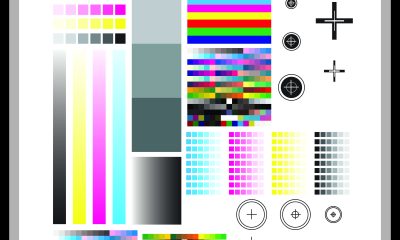I’ve received a number of e-mails about my last Shop Talk column, “Screen Printers Fight Back.” Most were from printers in other states, wondering whether they’ll have to deal with a licensing scheme in their area. Luckily, as far as my sources tell me, the manufacturer’s license is only required in a few other jurisdictions—New York being one, where the cost is only $150 compared to California’s $750-2000 annual fee.
I’ve received a number of e-mails about my last Shop Talk column, “Screen Printers Fight Back.” Most were from printers in other states, wondering whether they’ll have to deal with a licensing scheme in their area. Luckily, as far as my sources tell me, the manufacturer’s license is only required in a few other jurisdictions—New York being one, where the cost is only $150 compared to California’s $750-2000 annual fee.
One has to question the need and ultimate result of the large difference in fees, or lack of them, between states and between countries. This unfair and unlevel playing field causes manufacturing to migrate and smaller, locally owned businesses to fold. Meanwhile, governments wonder why people support a grey economy and deal in cash.
A $2,000 fee for a business doing $2 million per year is chump change, but it can close the doors forever for many small shops. The stats tell us small business is the only part of the economy that is creating jobs. Wouldn’t it be something if governments were to stop paying lip service to this fact and, instead of wasting resources enforcing outdated regulations and levying fines, put their efforts into supporting the growth of small businesses?
More battles
In another area of the Empire of Squeegistan, the locals report attacks from Giclée Monsters in the form of unauthorized replicas of screen-printed rock posters showing up on eBay. This is actually a bigger problem than you might think, as the combination of high demand among collectors and fans, plus the ease of scanning and printing out copies and then selling them to unsuspecting suckers is just a little too tempting for some people.
Advertisement
It’s copyright infringement, and it affects the artists who create the prints and the bands whose names, in many cases, sell the poster. The originals were created and printed for a specific gig and signed in limited numbers. The eBay scammers save a file and then just print the replica posters off as needed. Maybe the scale isn’t the same, but it’s no different than counterfeit Gucci bags or fake Rolex watches, although these cheap knockoffs are made in the USA!
My buddies over at the American Poster Institute (API), the artists who make this stuff, jump on the scammers right away. When one discovers an eBay Store with fakes being flogged, artists are alerted and the fun begins.
The smart artists register for the VERO program on eBay. This is an effective block that results in the replica material being pulled. Sellers on eBay who persist in selling fakes are run off of the Website, although they usually resurface under a different name and continue the fraud. Another tactic is for the artist to contact the seller directly and issue an order to cease and desist—although this is mostly hot air, as no artists I know can afford the lawyers needed to go after the perps.
Off to war
While we are on the subject of screen printers fighting back, I’ve had an opportunity to peek inside the upcoming book, “A History of Screenprinting—How an Art Evolved into an Industry.” This will be out in early 2012, available through ST Media Group. It traces the growth of the secret process from its early roots in the 1800s up through the 1950s. Author Guido Lengwiler, a professor of screen printing in Switzerland, has done a great job piecing together this fascinating story. My favorite chapter is devoted to screen printing in WWII.
From full-size tank images stretched over wood frames used to fool the Nazis before the D-Day landings, to ceramic tiles printed in Holland that would spell out Resistance slogans when combined a certain way, screen printers were very much in the thick of it. On the home front, they cranked out everything from propaganda posters to top-secret proximity fuses for bombs.
Many mobile sign shops followed the troops into areas so devastated that signs and posters were the only mass-communication media. With new paper rationed or commandeered for the war effort, screen printers—especially in Europe—remained busy overprinting old newspapers with flood coats and printing new information and images on top. Printed circuits, control panels for airplanes and jeeps, insignia for uniforms, flags, and banners were some of the other products made by screen printers to help win the war.
Advertisement
Being a screen printer will always be a struggle. What do you expect when your main weapons consist of a piece of synthetic rubber and a square of cloth? Whether it’s government tax collectors in California or some competitor down the block or in the next country undercutting you by a nickel, you have to find a way to fight through the problem. Sometimes it requires you to charge forward and adopt new equipment to improve efficiency or expand into new product areas. Sometimes it requires you to rethink and reeducate yourself and your fellow workers and change the way you process jobs or adapt to new technologies and methods. And sometimes you have to retreat, regroup, and downsize the operation so you can live to fight—and print—another day.


 Case Studies2 months ago
Case Studies2 months ago
 Art, Ad, or Alchemy2 months ago
Art, Ad, or Alchemy2 months ago
 Andy MacDougall2 months ago
Andy MacDougall2 months ago
 Columns3 weeks ago
Columns3 weeks ago
 Editor's Note3 weeks ago
Editor's Note3 weeks ago
 Marshall Atkinson3 weeks ago
Marshall Atkinson3 weeks ago
 Thomas Trimingham2 months ago
Thomas Trimingham2 months ago
 News & Trends2 months ago
News & Trends2 months ago
















